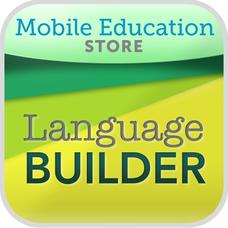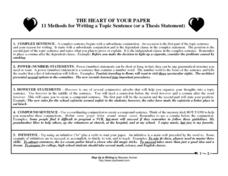Curated OER
Lesson: A Garden Party of My Own
Kids look at a beautiful work of art to practice grammar, make connections from life to art, and sketching. They identify all the parts of grammar they see in the image, discuss what they see and do on a picnic, and then draw an imaged...
Curated OER
Lesson: Paul Chan: Alternumeric Fonts
Learning to analyze language, symbols, and codes is part of becoming a deep and critical thinker. Young analysts consider their ability to see hidden messages as they analyze the work of Paul Chan. There are two fully developed...
Curated OER
When Is It O.K. to Replace Human Limbs With Technology?
Today's blog topic is robotic limb replacement for amputees. Upper graders read the related article and argument, then compose a blog response that addresses the questions provided. This is a great way to get kids thinking about ethics,...
Santa Monica-Malibu Unified School District
Parts of Speech Pronouns: Building Blocks of Grammar
Pronouns are the most helpful parts of speech! Model the ways that interrogative, indefinite, personal, and demonstrative pronouns can specify meaning and enhance writing with a hands-on activity.
K12 Reader
Working with Adverbs
Encourage critical thinking with a grammar exercise that focuses on adverbs and adverbial phrases. Kids read the first parts of 16 sentences, then decide which question to answer (how, how much, where, or when) based on the context, and...
Curated OER
Testing... Testing...
Students demonstrate critical- and creative-thinking skills to develop test questions. They write clear test questions or statements using correct grammar, spelling, and sentence structure.
Curated OER
Leaks and Gossip: Examining WikiLeaks Through Political Cartoons
Use political cartoons to spice up a discussion on national security! Two cartoons, one by Normal Rockwell in 1948, the other a parody of Rockwell's by Chuck Asay in 2010, depict the dangers of leaking information. Background information...
Curated OER
Lesson: Before You Go...Travel Recommendations from the Experts!
Here is a lesson that sounds like a lot of fun. Kids discuss the artistic elements and motives for the painting, Grand Canyon of the Yellowstone. To get the scope and scale of this oversized masterpiece, they use butcher paper and the...
Mobile Education Store
LanguageBuilder for iPad
Help your child hone his/her verbal communication skills and basic understanding of sentence structure with an app that promotes descriptive verbal interactions. The child is presented with an image, prompted to make a sentence, and then...
Curated OER
Food and Dialect
The dialect words for types of food from across the British Isles get pupils thinking about native dialects and how they differ from Standard English. Class members create a dialect dictionary and discuss the difference between accent...
Curated OER
Walk Two Moons: DR-TA, Chapter 17: “In the Course of a Lifetime”
Use this question and answer worksheet as an assignment for Sharon Creech's Walk Two Moons. The questions listed support better comprehension and critical thinking of chapter seventeen.
Curated OER
The Heart of Your Paper: 11 Methods for Writing a Topic Sentence (or a Thesis Statement)
Help your young writers produce high-quality topic and thesis statements that go beyond basic wording and really illustrate complex ideas and critical thinking skills. From however and compound sentence statements to using...
Curated OER
Hatchet: Vocabulary Strategy
Want your class to use critical thinking when discussing vocabulary? Go beyond the dictionary with a vocabulary activity based on Gary Paulsen's Hatchet. Kids write the word in the center of a graphic organizer that also provides...
Curated OER
When Is a Noun a Verb? Examining Double Duty Words
The New York Times' Learning Network provides great lessons! This one uses articles from the paper to help readers understand homonyms like mail (verb and noun). It also includes an exercise in reading informational text. Links to the...
Grammar Net
Past Simple v. Past Perfect Simple
Help English learners tell the difference between the past tense and the past perfect tense with a grammar instructional activity. As kids read twelve sentences, they change the given verbs to the correct tense based on context clues.
Novelinks
The Book Thief: Cubing Strategy
Whether used to review prior to a reading assessment or as a way to generate ideas for an essay, this activity is sure to encourage critical thinking about Markus Zusak's The Book Thief. Kids create a six-sided question cube with each...
K12 Reader
Color the St. Patrick’s Day Adjectives
Who needs luck when you've got grammar skills? Celebrate St. Patrick's Day in language arts class with a fun coloring activity that prompts young readers to color all adjective sections green.
Curated OER
Fahrenheit 451: Social Criticism
Students write a four paragraph essay that tells about two things in society that Ray Bradbury criticizes in the book, Fahrenheit 451. For this social criticism lesson, students develop a thesis based on their reading of the book and...
K12 Reader
Adverbs of Frequency II
Describe your daily activities with adverbs of frequency. Kids recall which things they seldom do, they rarely do, they frequently do, and the things that they never do.
Apache
Gerunds and Infinitives
Learning proper grammar rules for a middle school student can be difficult, especially in a texting world, but this resource demonstrates how the verb changes by adding a gerund or infinitive. Keep up the texting, but use this to...
Novelinks
The Heart is a Lonely Hunter by Carson McCullers: Literary Mandala
Explore the concept of yin and yang with this resource. On the first page, learners study a picture of George Bush. Then, have learners choose a character from The Heart is a Lonely Hunter. After brainstorming adjectives and choosing...
Mr. Ambrose
The Great Gatsby, F. Scott Fitzgerald
Good discussion questions, quizzes, and tests teach as well as assess. Readers of The Great Gatsby will learn much from the materials in a 36-page packet designed to help students prepare for the AP Literature exam. Included in the...
Curated OER
MONSTERS AND MYTHS: SCRIPTS /SCULPTS
Seventh graders are introduced to myths formed by many cultures as a unique genre of literature. They use critical thinking skills to compare and contrast mythic tales, compare versions of the same story, and respond to literature in...
Azar Grammar
Students as “Grammarians”: Discovering Grammatical Rules Lesson on the Causative “Have”
Groups examine a series of examples, identify the common elements, and work together to discover "the causative" grammar rule represented.

























